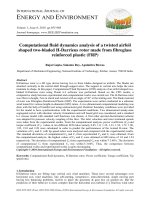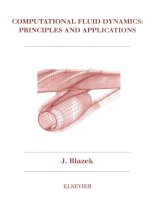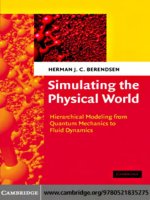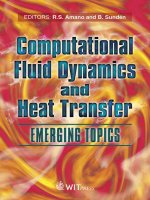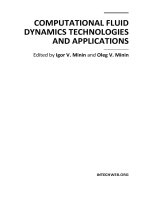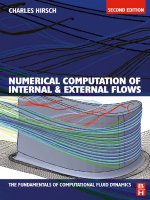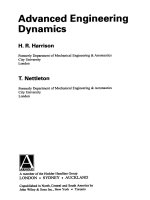ADVANCED FLUID DYNAMICS pdf
Bạn đang xem bản rút gọn của tài liệu. Xem và tải ngay bản đầy đủ của tài liệu tại đây (17.12 MB, 282 trang )
ADVANCED
FLUID DYNAMICS
Edited by Hyoung Woo Oh
Advanced Fluid Dynamics
Edited by Hyoung Woo Oh
Published by InTech
Janeza Trdine 9, 51000 Rijeka, Croatia
Copyright © 2012 InTech
All chapters are Open Access distributed under the Creative Commons Attribution 3.0
license, which allows users to download, copy and build upon published articles even for
commercial purposes, as long as the author and publisher are properly credited, which
ensures maximum dissemination and a wider impact of our publications. After this work
has been published by InTech, authors have the right to republish it, in whole or part, in
any publication of which they are the author, and to make other personal use of the
work. Any republication, referencing or personal use of the work must explicitly identify
the original source.
As for readers, this license allows users to download, copy and build upon published
chapters even for commercial purposes, as long as the author and publisher are properly
credited, which ensures maximum dissemination and a wider impact of our publications.
Notice
Statements and opinions expressed in the chapters are these of the individual contributors
and not necessarily those of the editors or publisher. No responsibility is accepted for the
accuracy of information contained in the published chapters. The publisher assumes no
responsibility for any damage or injury to persons or property arising out of the use of any
materials, instructions, methods or ideas contained in the book.
Publishing Process Manager Jana Sertic
Technical Editor Teodora Smiljanic
Cover Designer InTech Design Team
First published March, 2012
Printed in Croatia
A free online edition of this book is available at www.intechopen.com
Additional hard copies can be obtained from
Advanced Fluid Dynamics, Edited by Hyoung Woo Oh
p. cm.
ISBN 978-953-51-0270-0
Contents
Preface IX
Chapter 1 An Experimental and Computational Study of
the Fluid Dynamics of Dense Cooling Air-Mists 1
Jesús I. Minchaca M., A. Humberto Castillejos E.
and F. Andrés Acosta G.
Chapter 2 Direct Numerical Simulations of
Compressible Vortex Flow Problems 21
S.A. Karabasov and V.M. Goloviznin
Chapter 3 Fluid Dynamics of Gas – Solid Fluidized Beds 39
Germán González Silva, Natalia Prieto Jiménez
and Oscar Fabio Salazar
Chapter 4 Fuel Jet in Cross Flow –
Experimental Study of Spray Characteristics 59
E. Lubarsky, D. Shcherbik, O. Bibik, Y. Gopala and B. T. Zinn
Chapter 5 Influence of Horizontal Temperature Gradients on
Convective Instabilities with Geophysical Interest 81
H. Herrero, M. C. Navarro and F. Pla
Chapter 6 Internal Flows Driven by Wall-Normal Injection 95
Joseph Majdalani and Tony Saad
Chapter 7 Modelling of Turbulent Premixed
and Partially Premixed Combustion 135
V. K. Veera, M. Masood, S. Ruan, N. Swaminathan and H. Kolla
Chapter 8 Multiscale Window Interaction and Localized
Nonlinear Hydrodynamic Stability Analysis 159
X. San Liang
Chapter 9 Stability Investigation of
Combustion Chambers with LES 183
Balázs Pritz and Martin Gabi
VI Contents
Chapter 10 Turbulent Boundary Layer Models:
Theory and Applications 205
José Simão Antunes do Carmo
Chapter 11 Unitary Qubit Lattice Gas Representation
of 2D and 3D Quantum Turbulence 239
George Vahala, Bo Zhang, Jeffrey Yepez,
Linda Vahala and Min Soe
Preface
This book is intended to serve as a reference text for presenting a broad range of topics
on fluid dynamics to advanced scientists and researchers. The chapters have been
contributed by the prominent specialists in the field of fluid dynamics cover
experimental and numerical fluid dynamics, aeroacoustics, multiphase flow analysis,
convective instability, combustion, and turbulence modeling.
Dr. Hyoung Woo Oh
Department of Mechanical Engineering,
Chungju National University,
Chungju,
Korea
1
An Experimental and Computational Study of
the Fluid Dynamics of Dense Cooling Air-Mists
Jesús I. Minchaca M., A. Humberto Castillejos E.
*
and F. Andrés Acosta G.
Centre for Research and Advanced Studies – CINVESTAV, Unidad Saltillo
Mexico
1. Introduction
Spray cooling of a hot body takes place when a dispersion of fine droplets impinges upon its
surface to remove a large amount of heat by evaporation and convection (Deb & Yao, 1989).
In metallurgical processes such as continuous casting of steel (Camporredondo et al., 2004)
the surface temperature, T
w
, of the hot steel strand exceeds considerably the saturation
temperature, T
s
, of the cooling liquid (water), i.e., T
w
-T
s
ranges between ~600 to 1100°C.
These harsh temperature conditions have traditionally called for the use of high water
impact fluxes (w, L/m
2
s) to remove the heat arriving to the surface as a result of the
solidification of the liquid or semi-liquid core of the strand. The boundary between dilute
and dense sprays has been specified at w= 2 L/m
2
s (Deb & Yao, 1989, Sozbir et al., 2003). In
modern continuous casting machines the w found are well above this value. Most of the
impingement area of the spray or mist jets will have w 10 L/m
2
s, with regions where w can
be as large as ~110 L/m
2
s. Heat treatment of alloys requiring the rapid removal of large
amounts of heat also makes use of dense sprays or mists (Totten & Bates, 1993).
Sprays and air-mists are dispersions of drops produced by single-fluid (e.g., water) and
twin-fluid (e.g. water-air) nozzles, respectively. In sprays, the energy to fragment the water
into drops is provided by the pressure drop generated across the narrow exit orifice, while
in air-mists nozzles a high speed air-stream breaks the water-stream generating fine, fast-
moving droplets (Lefebvre, 1989; Nasr et al., 2002). In air-mist nozzles with internal mixing
and perpendicular inlets for the fluids, as those shown in Fig. 1, the water splatters against a
deflector surface and the resulting splashes are further split by the shear forces exerted by
the axial air-stream, which also accelerates the drops as they move along the mixing
chamber toward the exit port. Thus, the liquid emerges in the form of drops with different
sizes and velocities and with a non-uniform spatial distribution (Hernández et al., 2008).
In addition to w, the size, d
d
, and velocity, u, of the drops in dense air-mists play a crucial
role in the cooling of highly superheated surfaces (Bendig et al., 1995; Jenkins et al., 1991;
Hernández et al., 2011). This behavior stresses the important relationship between the heat
transfer process and the droplet impact or deformation and break-up behavior. Since, for a
specified fluid those two parameters, d
d
and u, determine the local impingement Weber
number (We
zs
=
d
u
zs
2
d
d
/), which in general has been agreed to characterize the impact
behavior (Wachters & Westerling, 1966; Araki & Moriyama, 1981; Issa & Yao, 2005). As the
*
Corresponding Author
Advanced Fluid Dynamics
2
impingement Weber number increases the drops tend to deform more widely, break more
profusely, stay closer to the surface and agitate more intensively the liquid film formed by
previous drops. Thus, it is clear that knowledge of the local parameters characterizing free
mist-jets is needed to arrive to a quantitative description of the fluid dynamic interaction of
drops with a surface and of the boiling-convection heat transfer that would result.
Experimentally, the water impact flux has been the parameter most frequently determined,
using a patternator (Camporredondo et al., 2004; Puschmann & Specht, 2004). The drop size
distribution in mists has often been measured by: (a) laser diffraction (Jenkins et al., 1991;
Bul, 2001), (b) phase Doppler particle analysis, PDPA (Bendig et al., 1995; Puschmann &
Specht, 2004) and (c) particle/droplet image analysis, PDIA (Minchaca et al., 2011). The last
two methods allow the simultaneous determination of the droplet velocity and hence of the
correlation between both parameters. To the best knowledge of the authors only PDIA has
been used for the characterization of dense sprays and mists. Particle image velocimetry,
PIV, has been employed for measuring the velocity of drops in dense mists, but the
technique did not allow the simultaneous determination of size (Hernández et al., 2008).
Recent works have presented a detailed experimental characterization of the local variation
of w, d
d
and u obtained with typical air-mist nozzles, operating over a wide range of
conditions of practical interest (Minchaca et al., 2011; Hernández et al., 2011).
The phenomena involved in the atomization of a liquid stream are very complex and therefore
the generation of drops and their motion are generally treated separately. Knowledge of the
influence of the fluid physical properties, nozzle design and operating conditions on
atomization is crucial to generate drops with the size distribution that would perform better
the task for which they are intended. The best well-known method for modeling drop size
distributions is the empirical method (Babinski & Sojka, 2002). This consists in fitting a curve to
data collected over a wide range of nozzles and operating conditions. In the case of nozzles
with internal mixing and 90° intersecting streams of air and water, the number and volume
frequency distributions of drop size have been adequately modeled by log-normal and
Nukiyama-Tanasawa, NT, distribution functions (Minchaca et al., 2011), respectively. The
statistical parameters of the distributions have been correlated with the water and air inlet
pressures allowing the prediction of different characteristic mean diameters, over a wide range
of operating conditions. Alternative modeling approaches are the maximum entropy and the
discrete probability function methods (Babinski & Sojka, 2002).
Two-phase flow models generally treat the continuous phase (e.g., air) in an Eulerian frame
of reference while the disperse phase (e.g., water droplets) is considered by either one of two
approaches: (a) Eulerian representation, which treats it as a continuum whose characteristics
(e.g., velocity, concentration, etc) are declared and updated at grid cells shared with the
continuous phase, and (b) Lagrangian representation, where the drops characteristics (e.g.,
position, velocity, concentration, etc) are tracked along their path-lines (Crowe et al., 1998).
The Eulerian-Eulerian approach is best suited for flows of monodisperse or narrow size
range drops. But models have been developed to handle efficiently polydisperse sprays by
describing the distribution of sizes through the moments of the droplet distribution function
(Beck & Watkins, 2002). The Eulerian-Lagrangian approach can handle more efficiently a
large range of particle sizes and give more details of the behavior of individual particles and
of their interaction with walls. Both approaches use submodels to represent phenomena
such as droplet break-up, droplet-droplet collisions, droplets-wall interaction, etc.
A two-dimensional (2-D) transient Eulerian-Lagrangian model was developed to describe
the motion of air and drops in a domain that included the nozzle chamber, the free jet and
An Experimental and Computational Study of the Fluid Dynamics of Dense Cooling Air-Mists
3
the impingement region (Hatta et al., 1991a, 1991b). The researchers considered mono-
disperse drops with sizes of 1 and 10 µm and found that the motion of both phases
depended strongly on the particle size. More recently, a computational model was
developed to calculate the in-flight and impingement motion of air and droplets with a size
distribution (Issa & Yao, 2005). The rebounding of multiple drops from the surface was
simulated by extending empirical information regarding the variation of the normal
coefficient of restitution of single droplets with the impingement We
zs
. The authors claimed
that large drops with high momentum tended to impinge closer to the stagnation point,
whereas smaller drops tended to collision farther away because they were entrained by the
air. In another study, the equation of motion for drops projected horizontally in quiescent
air was solved considering sizes ranging from 100 to 1000 µm and velocities of 20 m/s and
50 m/s (Ciofalo et al., 2007). It was found that drops smaller than 100 µm would experience
large deflections due to gravity, and would never reach a plane beyond 0.25 m.
The sprays and mists that have been studied experimentally and computationally are far
apart from those used in important metallurgical processes. In recent studies the authors
presented a 3-D computational fluid dynamic (CFD) Eulerian-Lagrangian model for free
dense air-mist jets (Hernández et al., 2008). However, since new and rigorous experimental
information has been generated the model has been refined in regard to the size distribution
imposed at the nozzle orifice. The experimental information generated in this work has also
enabled to carry out a detailed validation of the model. The model predicts very well the
correlation between drop velocity and particle size, the velocity and trajectory of the drops
and the water impact density as a function of the nozzle operating conditions, over the
whole range of practical interest.
2. Experimental methods and conditions
A schematic of the experimental set-up used for measuring the mist parameters is displayed
in Figure 1. It consists of: (a) a patternator for measuring water impact density distribution,
(b) a particle/droplet image analysis, PDIA, system for acquiring and analyzing the images
of fine moving droplets to determine their size and velocity and (c) a water and air supply
system for the nozzle.
To determine w the nozzle was oriented horizontally and this parameter was evaluated
collecting the drops entering tubes with an area a, to measure the total volume of water v
accumulated during a period of time t in the bottles connected to the tubes. The collecting
tubes were arranged forming a grid and their diameter and spacing are given in Figure 1.
Hence, the local water impact flux at a position x-y-z was calculated according to the
following expression,
tcosa
)z,y,x(v
)z,y,x(w
(1)
where (cos is the direction cosine of the angle formed between the nozzle axis and the line
connecting the centers of the nozzle orifice and of a given tube, i.e., (a cos gives the
projected area of a tube perpendicular to the direction of motion of the drops. The accuracy
of the measured w distributions was verified by integrating w over the impingement area to
compare it with the total water flow rate, W. In general, the computed W had an error
smaller than ±10 %.
Advanced Fluid Dynamics
4
Fig. 1. Schematic of experimental setup
The PDIA system (VisiSizer N60V, Oxford Laser Ltd. Didcot, United Kingdom) schematically
illustrated in Fig. 1 is a spatial multiple counting apparatus that captures instantaneously (i.e.,
in 4 ns) shadow images of the droplets moving through a thin (~400 m) sampling volume
and analyzes them in real time (Minchaca et al., 2011). A dual head Nd:YAG laser sends light
pulses (15 mJ at 532 nm) through a fluorescent diffuser to illuminate the region of interest from
behind while a high resolution camera placed in front captures the shadow images of the
objects passing in between. The disposition of these elements is illustrated in the figure.
Operating in dual pulse mode the laser and camera are triggered to capture image pairs
separated by a time interval of 1.7 s, the figure displays a single pair extracted from
superposed frames. The analysis of single and superposed frames allows, respectively, the
simultaneous determination of the size and velocity of the drops appearing. The criteria
employed for the consideration of single drops and drop pairs have been described elsewhere
and were validated by off-line analysis of single and superposed frames (Minchaca, 2011;
Minchaca et al., 2011). Lenses with two magnifications (2×, 4×) were employed to resolve the
whole spectrum of drop sizes. With each magnification 1000 frames were captured to obtain
samples with over 5500 drops that ensured statistical confidence limits of 95 % (Bowen &
Davies, 1951). The magnifications allowed resolving drops with sizes ranging from 5 m to 366
m and velocities of up to 185 m/s. The field of view with both magnifications was
2.561×2.561 mm
2
, which allowed combination of the samples obtained from both to carry out
statistical analysis of the data. The calibration (i.e., m/pixel) provided for the camera, lens
and magnifications used was validated measuring standard circles in a reticule and standard
line spacings in a grating and the agreement was better than 0.5 %. The traversing rail shown
in the figure moved the diffuser and camera to 7 prescribed x-positions (0.0013, 0.030, 0.059,
0.088, 0.116, 0.145 and 0.174 m), while the y and z
s
positions where maintained constant at 0 m
and 0.175 m, respectively. Differently from the measurements with the patternator the
measurements with the PDIA system were carried out with the nozzle oriented vertically
downward, but it was experimentally verified that the distributions of d
d
and u obtained with
both orientations were not significantly different.
The water for the pneumatic nozzle was supplied from a reservoir using an immersion
pump instrumented with a digital turbine flow-meter, a valve and a digital pressure gauge.
A compressor provided the air and this line was instrumented with an automatically
An Experimental and Computational Study of the Fluid Dynamics of Dense Cooling Air-Mists
5
controlled valve, to minimize flow rate variations, a mass flow-meter and a digital
manometer. The results reported in this article are for a Casterjet 1/2-6.5-90 nozzle
(Spraying Systems Co., Chicago, IL), whose operating diagram is displayed in Figure 2. The
conditions investigated are indicated by the triangles drawn in the plot, and it is seen that
they correspond to constant W with different air inlet pressures, p
a
, and vice versa.
Fig. 2. Measured operating diagram of a Casterjet 1/2-6.5-90 nozzle
3. Mathematical model and computational procedure
3.1 System considered and assumptions
The 3-D system domain considered in the model is shown in Fig. 3(a), it includes the two-
phase free-jet issuing from a pneumatic nozzle and the surrounding environment; the
mixing chamber is excluded from the analysis. Since the visualization of the jets and the
Fig. 3. (a) Schematic of system considered and computational domain, (b) quadruple
exposure PIV image of drops in the neighborhood of the nozzle orifice, (c) schematic of
assumed air-velocity profiles at nozzle exit and (d) schematic of assumed drop velocity
profiles and water flux distribution at nozzle exit
(c)
(d)
(a)
(b)
Advanced Fluid Dynamics
6
measurements of their impact footprints indicated double symmetry over the x–z and y–z
planes the computational domain involved just one quarter of the physical domain, as seen
in the figure. Additionally, since the air- and water-flow rates were stable it was assumed
that on a time average basis, the flow characteristics of the two-phase jet could be simulated
in steady-state conditions. For their treatment the continuous air-phase was considered in an
Eulerian frame of reference and the discrete droplets were regarded in a Lagrangian frame.
The assumptions for the model were: (a) the liquid emerges from the nozzle as drops. This is
supported by PIV observations done close of the nozzle orifice, as that displayed in Figure
3(b). This figure shows a quadruple-exposure photograph with trails of 4-images of
droplets. Additionally and in agreement with PDIA observations the drops are assumed
spherical; (b) the size distribution of the drops exiting the orifice is equal to the distribution
measured at a distance z= z
s
(i.e., at the typical working distance of a given nozzle). This is
reasonable since drop coalescence and break-up are rare events. The low volume fraction,
d
of the drops prevents coalescence and the PDIA images, taken at different positions in
the free mists, rarely show droplet break-up; (c) drops of all the specified sizes leave the
orifice at the terminal velocity reached in the mixing chamber while dragged by the air.
Calculations indicate that this would be the case for individual drops and since
d
is low the
assumption would seem reasonable for the dilute multi-drop system moving within the
chamber; in the mixing chamber
d
< 0.08; (d) the droplets in the jet do not interact with each
other and only interact with the air through interfacial drag, and (e) the air and the droplets
are at room temperature and condensation and vaporization are negligible.
3.2 Governing equations
Under the considerations just described, the governing equations for the motion of the air
are: the continuity equation (2), the Navier-Stokes equations (3) and the turbulence transport
equations (4) and (5), which are expressed as follows,
0
x
U
i
i
(2)
i
i
j
j
i
t
jji
j
i
S
x
U
x
U
)(
xx
p
x
U
U
(3)
j
i
i
j
j
i
t
i
k
t
ii
i
x
U
x
U
x
U
x
k
xx
k
U
(4)
k
Cf
x
U
x
U
x
U
k
Cf
xxx
U
2
22
j
i
i
j
j
i
t11
i
t
ii
i
(5)
S
i
in Eq. (3) is the source term expressing the i-direction momentum transferred between the
air and the drops in a given cell of the fixed Eulerian grid over a Lagrangian time step. It is
equal to the change in the momentum (only due to interfacial drag) of the drops following
all the trajectories traversing a cell over that time step (Crowe et al., 1977) and it is given as,
k
n
1k
in,iout,i
3
dd
cell
d
i
))uu(dN(
v6
S
cell
(6)
An Experimental and Computational Study of the Fluid Dynamics of Dense Cooling Air-Mists
7
The meaning of the symbols appearing in the equations is given in Section 7. The turbulence
of the air was treated by the k- model for low Reynolds flows of Lam-Bremhorst modified
by Yap, 1987. The constants and functionsappearing in Eqs. (4) and (5) are listed in Table 1.
Also, under the considerations done in Sec. 3.1 the equation of motion for individual drops
in the mist and under the effects of aerodynamic drag and gravity is expressed as,
i
d
iiii
dd
D
i
g)1()uU(uU
d
C
4
3
dt
du
(7)
The drag coefficient C
D
was assumed to vary with the particle Reynolds number, Re
d
,
according to the expressions given in Table 1. The trajectory of the drops was computed
from the variation with time of the components of the position-vectors, according to,
i
i
u
dt
dx
(8)
Constants and functions involved in the turbulence model
C
1
= 1.44; C
2
= 1.92; C
d
k
= 1.0;
= 1.3
3
22
'12
20.5 0.05
(1 exp( 0.0165Re )) 1 ; 1 ; 1 exp( Re )
Re
zt
t
fff
f
where,
2
d
t
k
Cf;
2
t'z
k
Re;
'zk
Re
Drag coefficient expressions
Stokes law region, Re
d
2 C
D
= 24/Re
d
Intermediate region, 2 ≤ Re
d
≤ 500 C
D
=
d
Re/10
Newton’s law region, 500 ≤ Re
d
≤ 210
5
C
D
= 0.44
where
ii
d
d
uUd
Re
Boundary conditions at nozzle exit
Drop-phase Air-phase
u
x,k
= u
z,t
sin(x/l
x
)
u
y,k
= u
z,t
sin(y/l
y
)
2/1
2
k,y
2
k,x
2
t,z
k,z
uuuu
0 x l
x
’
U
x
= 0, U
y
= 0, U
z
= U
z,max
l
x
’x l
x
U
x
= U
z,max
(tan
x)
, U
y
= 0
U
z
= U
z,max
(l
x
- x)/(l
x
- l
x
’)
x
= (x - l
x
’)/(l
x
- l
x
’)
U
z,max
= (A+W)/ [2l
y
(l
x
+ l
x
’)] *
0xl
x
)ll4/()ll(k2;U01.0k
yxyx
5.1
oo
2
,maxzo
Physical properties
= 1.02 kg/m
3
; = 1.8×10
-5
Pa s;
d
= 998 kg/m
3
Nozzle dimensions and parameters
l
x
= 0.01 m; l
y
= 0.00325 m; l
x
’= 0.00585 m
z
s
= 0.175 m; = 45°; = 10°
*A is computed at local conditions: 25°C, 86 kPa.
Table 1. Auxiliary equations, properties and dimensions
Advanced Fluid Dynamics
8
3.3 Boundary and initial conditions
At the boundaries of the calculation domain shown in Fig. 3(a), Eqs. (2) through (5)
describing the turbulent motion for the air-phase were solved imposing the following
conditions:
-
Ambient conditions at boundaries ABCD, A'B'C'D', ABB'A' and BCC'B', specified as,
amb
P P ;k e 0
(9)
To approach these conditions, the boundaries were located far away from the jet.
-
Symmetry conditions at the boundaries ADD'A', DCC'D', given as:
0
xx
k
x
U
U
jjj
i
j
(10)
where j represents the index for the coordinate normal to the respective symmetry plane.
-
Non-penetration and non-slip conditions were specified at the external wall of the nozzle,
i
U k ε 0
(11)
-
Air velocity profiles as those shown in Fig. 3(c) were specified at the nozzle orifice, which
corresponds to an internal boundary. Along the x
-direction these profiles were uniform
over the length l
x
’
of the flat hollow portion of the flanged orifice, in the rest of the orifice
the profiles decreased to zero varying in angle from 0 deg to deg at the edge; the
distributions were the same throughout the whole thickness (y-)direction of the orifice.
These velocity profiles were suggested by the geometry of the flanged orifice and are
supported by the results presented in Section 4. The expressions describing the profiles
are listed in Table 1, together with the expressions for the turbulence kinetic energy and
the dissipation rate of turbulence kinetic energy at this boundary, k
o
and
o
, respectively.
-
Positions and velocities were specified to the droplets as initial conditions for the solution
of their motion (7) and trajectory (8) equations. For doing this, a first step was to decide a
series of criteria to distribute throughout the orifice drops of different size and velocity in
a random fashion that reflected that the water flux profile decreases from its center to its
edges. To do this, the orifice was simulated as a grid of ports, k, releasing drops satisfying
the diameter distribution measured at z= z
s
(according with the assumption indicated in
Section 3.1) for the particular set of nozzle operating conditions under consideration. For
deciding the number of ports assigned to each drop size category it is important to
establish what type of distribution to use, number or volume frequency? Figure 4 shows
both size distributions measured for a representative set of operating conditions W and
p
a
. The number frequency distribution shows that droplets smaller than 25 m account for
a large number percentage of the drops (82.85 % of them), but that they represent only
6.82 % of the volume of the drops in the sample. Since the number of ports that can be
used cannot be excessively large the assignment of the ports according to the number
frequency distribution would leave many sizes unrepresented. The volume frequency
distribution does not present this disadvantage and was chosen to designate the number
of ports for each size category. The size assigned to each port was done through a random
number generator to simulate the stochastic emergence of drops with different
characteristics from distinct sites of the orifice. The drops with volume v
d,k
= (d
d
3
)
k
/6
exiting the ports k with a number frequency, N
d,k
, had to satisfy the water-flow rate, W,
according to the following expression,
An Experimental and Computational Study of the Fluid Dynamics of Dense Cooling Air-Mists
9
,,
1
T
n
dk dk
k
WNv
(12)
Furthermore, based on the form of the mist footprint obtained with a patternator the water
flow was assumed to be distributed in the orifice according to an obelisk-shaped
distribution (Camporredondo et al., 2004), as that shown schematically in Figure 3(d).
With the criteria given, the initial conditions for Eqs. (7) and (8) were assigned to each port
of the nozzle orifice, such that at t = 0 the position and velocity of the drop are specified as
follows,
ii ii
kk
u uand x x
(13)
As mentioned in Sec. 3.1, the initial velocity, (u
i
)
k
, of the drops was prescribed by assuming
that the drops exit with the terminal velocity that they reach in the mixing chamber
(Minchaca et al., 2010). As suggested by the observed drop trajectories (Hernández et al.,
2008), according to the position assigned to the drop the angle of the velocity varied from 0
deg to deg in the x-direction and from 0 deg to deg in the y-direction. A schematic
representation of the velocity vectors of the drops is displayed in Fig. 3(d), and the
expressions for the u
x,k
, u
y,k
and u
z,k
velocity components are given in Table 1. Also, the
physical properties of the fluid, the dimensions of the orifice and the angles of expansion of
the jet are given in the table.
Fig. 4. Numeric and volume frequency drop size distributions measured for W= 0.58 L/s
and p
a
= 279 kPa. The log-normal and Nukiyama-Tanasawa, NT, distributions fitted to the
respective data are included
3.4 Solution procedure
The Eulerian and Lagrangian equations of the model were solved using the control volume
method and the particle tracking facility implemented in Phoenics. The mesh used had
128×25×99 control volumes to achieve mesh independent results and the number of ports
was 100×12 in the x-y directions. The convergence criterion specified a total residual for all
the dependent variables ≤ 10
-3
.
Advanced Fluid Dynamics
10
4. Experimental and computational results and discussion
4.1 Drop velocity and size correlation
As indicated in Sec. 2 the drop size and velocity measurements were done at 7 sampling
volumes spaced along the x-direction at y= 0 and z= z
s
. Figure 5 shows the correlation
between drop velocity and diameter for the set of measurements done over all the sampling
volumes. Droplets of all sizes exhibit a wide range of velocities when they arrive to the
measuring positions. It is noticed that as the droplet diameter decreases their velocities
exhibit a broader range, many small drops arrive at the measuring axis with small velocities
and this causes a weak positive correlation between droplet velocity and diameter, i.e., the
results denote a slight trend in the velocities to be larger as the size of the drops increases.
Correlation coefficients, for several conditions and positions, were evaluated quantitatively
in another work and confirm the weak positive correlation appreciated for the particular
case illustrated in the figure (Minchaca et al., 2011).
Fig. 5. Measured and calculated velocities for drops of different sizes reaching the x-axis at
y= 0 and z= z
s
. The results are for W= 0.58 L/s and p
a
= 279 kPa
Figure 5 also shows results of computed velocities for drops arriving at the measuring axis.
In agreement with the experiments, the results of the model reveal that the small drops
exhibit a broader spectrum of velocities than the larger ones, causing the development of a
weak positive correlation of velocity with size. Considering that the model assumes that all
drops of each size leave the nozzle at the particular terminal velocity that they reach in the
mixing chamber, as a result of the drag exerted by the air, the results of the figure indicate
that the smaller droplets are more susceptible to lose their momentum while moving in the
mist jet interacting with the air. This is evidenced by comparing the dispersion results with
the calculated terminal velocity curve included in the figure. From the nozzle exit the drops
follow ballistic nearly rectilinear trajectories and drops of the same size, which according to
the model exit at the same velocity, will decelerate more when leaving from external than
from internal positions of the nozzle orifice, so that they travel in the periphery of the jet
interacting with the quiescent environment. This statement is supported by the experimental
and computational results displayed in Fig. 6, which shows the variation of the normal and
tangential velocity components of drops of different size traversing the sampling volumes
An Experimental and Computational Study of the Fluid Dynamics of Dense Cooling Air-Mists
11
located at the different x-positions. The regression curves fitted to the experimental and
computational results show an excellent agreement. The dispersion exhibited by the
computed results displayed in Figs. 5 and 6 is smaller than the experimental due to the very
different number of drop trajectories traversing the sampling volumes, thousands in the
experimental case versus a few tens in the computational case. Despite of this the model is
able to represent very well the trend in the behavior of the actual system.
(a) (b)
Fig. 6. Measured and computed velocity components as a function of x-position for drops of
all sizes: (a) tangential velocity component and (b) normal velocity component. The results
are for W= 0.58 L/s and p
a
= 279 kPa
4.2 Effect of nozzle operating conditions on the velocity of the drops
4.2.1 Effect of water flow rate at constant air inlet pressure
In the application of air-mist nozzles for the cooling of surfaces at high temperature it is
common to vary the water flow rate maintaining constant the air inlet pressure. This
procedure would be equivalent to move along the curves of constant p
a
appearing in the
operating diagram of Figure 2. The reason behind this is that the spray cooling intensity is
commonly associated only to the flux of water impinging upon the hot surface, when
actually there is another mist parameter that plays an important role and this is the velocity
of the drops (Hernández et al., 2011). Experimentally, it has been found that the velocity of
the drops increases with W up to a certain value, but once this value is exceeded the
opposite effect takes place and the drop velocity decreases markedly (Minchaca et al., 2011).
With the increase in W at constant p
a
the drops generated by the nozzle become larger
(Minchaca et al., 2011) and the air flow rate, A, gets smaller as indicated by Figure 2. Both
factors will alter the terminal velocities that the drops will reach at the nozzle exit and also
their behavior in the free jet.
The multivariate effects that the droplet velocity experiences when changing W at constant
p
a
are complex. Therefore, it was important to examine the predictions of the CFD model in
Advanced Fluid Dynamics
12
this regard. Figure 7 shows experimental and computational profiles of the normal and
tangential volume weighed mean velocity components defined as,
N
1i
N
1i
3
i,d
3
i,d
i,xv,x
N
1i
N
1i
3
i,d
3
i,d
i,zv,z
d/duu;d/duu (14)
for four different water flow rates and a constant p
a
= 205 kPa. It is seen that both,
experimental and computational results, indicate that the increase in W from 0.1 to 0.3 L/s
causes an increase in the normal and tangential velocity components and that further
increase leads to a decrease in the velocities. The drop velocities obtained with W equal to
0.30 L/s and 0.58 L/s are considerably different, being substantially smaller for the higher
W. This behavior could be one of the factors of why the heat transfer does not augment
considerably when W and hence w do it (Montes et al., 2008). The computed velocities are
somewhat larger than the experimental because the volume frequency distribution of sizes,
chosen to establish the model, generates a greater number of large drops than small drops.
Fig. 7. Measured and computed volume weighed mean velocity components as a function of
x-position for different W and a constant p
a
. Normal velocity components: (a) measured, (b)
computed. Tangential velocity components: (c) measured, (d) computed
(a) (b)
(c)
(d)
An Experimental and Computational Study of the Fluid Dynamics of Dense Cooling Air-Mists
13
4.2.2 Effect of air inlet pressure at constant water flow rate
The computed and measured x- and z-components of the volume weighed mean velocity
are shown in Fig. 8, for conditions involving a constant W and different p
a
. The agreement
between computed and experimental results is quite reasonable and the curves show that as
p
a
increases both velocity components become larger. This behavior suggests that if the
drops were to impinge over a surface, a more intimate contact would take place as p
a
increases; this as a consequence of the higher impingement Weber numbers that would
result. The larger tangential velocity component of the drops hints a faster renewal of the
liquid on the surface as p
a
increases. In fact, heat transfer experiments have shown a
substantial increase in the heat flux with the increase in p
a
at constant W (Montes et al., 2008;
Hernández et al., 2011), suggesting that the change in the fluid dynamic behavior of the
drops with the increase in p
a
favors heat transfer. The phenomena occurring during the
impingement of dense air-mist jets with solid surfaces is being investigated. The effect of p
a
on the intensity of heat extraction could have important implications to achieve water
savings during cooling operations. Similar to the results in Fig. 7, the computed velocities in
Fig. 8 are somewhat larger than the experimental because the volume frequency distribution
of sizes tends to generate a greater number of large drops than small drops.
Fig. 8. Measured and computed volume weighed mean velocity components as a function of
x-position for different p
a
and constant W. Normal velocity components: (a) measured, (b)
computed. Tangential velocity components: (c) measured, (d) computed
(a)
(b)
(c)
(d)
Advanced Fluid Dynamics
14
4.3 Effect of air inlet pressure on droplet volume fraction and water impact flux
As mentioned in Sec. 1 the mists have been classified in dense or dilute according to the
value of the water impact density. However, little has been investigated about the actual
mist density defined as the volume of liquid of the drops per unit volume of space; which is
equivalent to the local liquid volume fraction,
d
. This parameter would give an indication
of how critical could be to the model the assumption that the drops in the free jet do not
interact as a consequence that they are far apart from each other. Although, the direct
experimental measurement of this parameter is difficult the validity of the computational
estimation of
d
can be tested by its relation with the water impact density. The local water
volume fraction can be defined by the following expression,
cell
kd
n
1k
d
d
v
)tvN(
cell
(15)
and the water impact density can be evaluated as,
)y,x(A
)vN(
)y,x(w
kd
n
1k
d
A
(16)
Figure 9 shows computed contour plots of
d
over the x-z symmetry plane of mist jets
generated with a constant water flow rate and different air nozzle pressures. It is
appreciated that as the air inlet pressure decreases the region close to the nozzle exhibits a
higher liquid fraction. This behavior arises from the larger size and smaller velocities of the
drops generated as p
a
decreases. For conservation of mass this last factor would imply that
Fig. 9. Computed contour maps of
d
over the main symmetry plane of the mist jet for a W=
0.50 L/s and p
a
of: (a) 205 kPa, (b) 257 kPa and (c) 320 kPa
(a)
(b) (c)
An Experimental and Computational Study of the Fluid Dynamics of Dense Cooling Air-Mists
15
the drops travel more closely spaced as p
a
decreases, leading this to a higher particle
packing. This behavior continues up to z= z
s
where regions of higher liquid volume fraction
are more widely spread in the case of smaller p
a
.
The predicted liquid fraction contours indicate that the increase in p
a
at constant W causes
a redistribution of the liquid in the free jet that could affect the water impact density. In
previous w measurements no effect was detected (Hernández et al., 2008). Thus, it was
decided to refine the patternator to try to reveal if there was an influence of p
a
on the
water impact density for a constant W. Figure 10 shows measured and computed water
impact density maps for p
a
of 257 kPa and 320 kPa with W= 0.50 L/s. It is seen that both
results agree very well and indicate an increase of the water impact density with the
increase in p
a
,
in the central region. Based on the model, this result points out that
although at higher p
a
the drops tend to travel more widely spaced from each other,
having a lower volume fraction, their higher velocities causes them to arrive more
frequently to the collecting cells of the patternator or equivalently to the virtual
impingement plane (in the case of the model), leading this to higher w in the central
region of the footprint. The differences observed in the figure between experimental and
computed results are mainly in the sizes of the footprint. This discrepancy arises because
the model considers the nominal value of the expansion semi-angle and a semi-angle =
10 deg. However, the w maps and the visualization of the jets indicate that the actual
angles were slightly larger than the nominal values.
Fig. 10. Contour maps of w at z= z
s
for a W= 0.50 L/s with p
a
= 257 kPa: (a) experimental, (b)
computational and with p
a
= 320 kPa: (c) experimental, (d) computational
(a)
(c)
(
b
)
(d)


